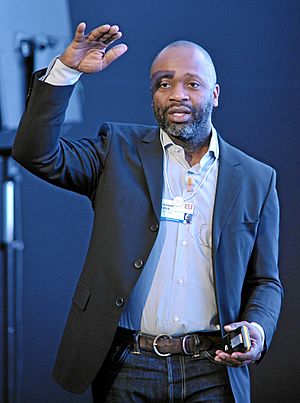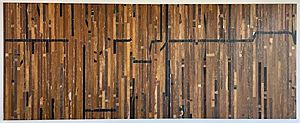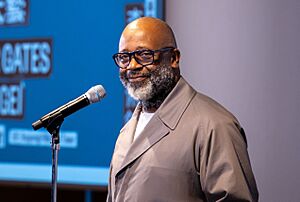Theaster Gates facts for kids
Quick facts for kids
Theaster Gates
|
|
|---|---|

Gates in 2013
|
|
| Born | August 28, 1973 |
| Known for | Installation art, Sculpture |
|
Notable work
|
Civil Tapestry series (2011-ongoing) Black Vessel for a Saint (2017) |
| Movement | Social practice, Urbanism |
Theaster Gates (born August 28, 1973) is an American artist and professor. He is known for his unique way of combining art with helping communities. He was born in Chicago, Illinois, where he still lives and works today.
Gates' art has been shown in museums and galleries around the world. His work often focuses on improving city areas, creating special places for people, and celebrating different cultures. He uses art to help neighborhoods that need support, especially after tough times like the 2008 financial crisis. He also highlights the importance of keeping records of Black culture and history.
Contents
Early Life and Learning
Theaster Gates grew up in East Garfield Park on the West Side of Chicago. He was the youngest of nine children and the only boy. His father worked as a roofer, and his mother was a school teacher. His sisters taught him about civil rights and fighting for fairness. His family went to a Baptist church, where Gates sang in the choir and became interested in performing. He went to Lane Technical High School.
In 1996, Gates finished college at Iowa State University. He earned a degree in urban planning, which is about designing and improving cities, and in ceramics, which is the art of making things from clay. After college, he focused on ceramics. He even spent a year in Tokoname, Japan, learning more about pottery. Later, in 1998, he earned another degree from the University of Cape Town in South Africa. This degree was in fine arts and religious studies.
His Art Projects
Early Art Creations
Gates' first art projects were based on his training in ceramics and his studies of different religions. Many of his early works explored how pottery was important in both Japanese and African-American cultures.
In 2007, Gates created an interesting art show called Plate Convergence. For this show, he made up a story about a Japanese potter named Shoji Yamaguchi. In the story, Yamaguchi moved to the United States after World War II and married a Black woman who was a civil rights activist. They designed a special plate for Black cuisine. This plate became central to dinner parties where people talked about art and politics. Gates made ceramic plates, filmed these "dinners," and created an exhibition space for them. He even had a mixed-race artist pretend to be Yamaguchi's son.
In 2008, Gates made another fictional place for his art. He called it the Center for the Proliferation of Afro-Asian Artifacts. Here, he showed an exhibition titled "Tea Shacks, Collard Greens and the Preservation of Soul."
In 2010, Gates created an exhibition at the Milwaukee Art Museum that focused on the work of another potter, David Drake. Gates used Drake's art to talk about the history of craft and race in African-American culture.
Rebuild Foundation
Gates started and leads the Rebuild Foundation. This is a non-profit group that uses culture and art to help improve neighborhoods that need it. They also create affordable spaces for people. The Rebuild Foundation works in the Greater Grand Crossing area of Chicago.
Through the Rebuild Foundation, Gates has bought and fixed up empty buildings. He turns them into cultural centers with special collections. For example, he renovated two houses on Dorchester Avenue, calling them the Archive House and the Listening House. The Archive House has 14,000 architecture books from a bookshop that closed. The Listening House has 8,000 music records that he bought when a record store closed.
Stony Island Arts Bank
In 2013, Gates bought the old Stony Island State Savings Bank from the city of Chicago. This bank is now called the Stony Island Arts Bank. It holds many important collections. These include the book collection of John H. Johnson, who started Ebony and Jet magazines. It also has the record collection of Frankie Knuckles, who is known as the "godfather of house music". The Arts Bank also has slides of art collections from the University of Chicago and the Art Institute of Chicago. In 2015, his work at the Stony Island Arts Bank was part of the first Chicago Architecture Biennial. The Bank also hosts art shows by other artists.
Art with Historical Collections


Theaster Gates often uses old collections related to African-American history in his art. This helps him explore ideas about history, memory, and how Black history and culture are valued. For example, his 2017 piece "plantation lullabies" used 4,000 items from the Edward Williams Collection. These items included old sheet music, signs, and figurines.
His project Black Image Corporation used photos from John H. Johnson's collection. It focused on Black photographers like Moneta Sleet Jr and Isaac Sutton, who were important during the civil rights era. Many of Gates' works use old objects that have a history of racism. For example, he has a series of works made with old firehoses, like In Case of ... Break the Glass (2011) and the Civil Tapestry series (2011-ongoing). Using firehoses reminds people of how police used them against protesters during the Civil Rights Movement.
In 2024, an exhibition at the Stony Island Arts Bank combined Gates' new art with historical items. These items included furniture and decor that Gates saved from the Johnson Publishing Company's building in Chicago.
University of Chicago Arts and Public Life
From 2011 to 2018, Gates was the first director of Arts + Public Life at the University of Chicago. In this role, he managed different art programs and worked with many artists and community members. He is also a full professor in the Department of Visual Arts at the university.
Gates also led the Place Lab. This was a project that worked to create new ways to develop cities. The Place Lab partnered with cities like Gary, Akron, and Detroit to help with urban improvements.
Other Art Shows and Performances
In January 2014, Theaster Gates designed a large art installation for the 95th Street subway station in Chicago. This was the biggest public art project ever for the Chicago Transit Authority. He also participated in major art shows like DOCUMENTA (13) in Germany in 2012. There, he restored an old building and held events and concerts. He was also part of the Whitney Biennial in New York in 2010 and had a solo show at the Museum of Contemporary Art, Chicago in 2013.
In May 2014, Gates and jazz pianist Jason Moran performed together in a show called Looks of a Lot. In 2015, he was invited to the 15th Istanbul Biennial. There, he set up a pottery shop in the old town, connecting African-American history and craft to local pottery.
In October 2015, Gates created an installation called "Sanctum" at Temple Church, Bristol, England. This project provided 24 days of continuous music and performances.
In October 2020, Gates opened a big show called Black Vessel at the Gagosian Gallery in New York City. This show explored themes of family, motherly love, and hard work. Many of the materials he used were roofing materials, honoring his father who was a roofer. The main part of the show was a gallery space lined with black bricks. Gates said that the COVID-19 pandemic and the time he spent alone helped him develop his ideas for the show.
His exhibition Future Histories: Theaster Gates and Cauleen Smith was at the SF MOMA from October 2020 to May 2021. A Clay Sermon was shown at London's Whitechapel Gallery from October 2020 to January 2021. This exhibition included a new film, ceramic pieces, and historical ceramics from different collections. As part of his London art events in 2021–2022, he also had shows at White Cube Mason's Yard and the Victoria and Albert Museum. The exhibition, Theaster Gates: When Clouds Roll Away: Reflection and Restoration from the Johnson Archive, opened at the Stony Island Arts Center in 2024.
The Smart Museum of Art plans to host Theaster Gates: Unto Thee from September 23, 2025, to February 22, 2026. This will be a large show that includes new paintings, sculptures, and films, along with some of his projects that involve restoring old objects.
Future Plans
Theaster Gates designed the 2022 Serpentine Pavilion for Serpentine Galleries. He is also part of a team working on The Waterfront Transformation: Canning Dock project in Liverpool, England. This project is part of a 10-year plan to improve the city's waterfront. They will redevelop buildings, including the Dr Martin Luther King Jr building, which will be central to the International Slavery Museum. Gates has said that Liverpool's Canning Dock is a very important historical site related to slavery in the UK. The team wants to show the truth of this history through monuments and memorials.
Awards and Honors
Theaster Gates has received many awards for his work:
- 2008 – Artadia Award
- 2012 – Fellow of United States Artists
- 2012 – "Innovator of the Year" by the Wall Street Journal
- 2013 – Inaugural Award of The Vera List Center for Art and Politics
- 2014 – International Artist Award, Anderson Ranch Arts Center
- 2015 – £40,000 Artes Mundi award in Cardiff, Wales
- 2015 – Honorary Doctorate of Fine Arts from San Francisco Art Institute
- 2015 – Smithsonian Magazine American Ingenuity Award for Social Progress
- 2016 – Kurt Schwitters Prize for 2017
- 2017 – Chevalier de l'Ordre national de la Légion d'honneur from the French Ambassador to the United States
- 2018 – Nasher Prize Laureate at the Nasher Sculpture Center
- 2018 – Urban Land Institute J.C. Nichols Prize for Visionaries in Urban Development
- 2021 – Frederick Kiesler Prize for Architecture and the Arts
- 2023 – Isamu Noguchi Award
- 2025 - Guggenheim Fellowship
Helping Others
Since 2016, Gates has been on the board of the Hirshhorn Museum and Sculpture Garden. In 2017, he helped choose the design for the Barack Obama Presidential Center in Chicago.
In 2018, Gates helped organize an auction in Miami to support the Global Fund's work against AIDS. This auction raised $10.5 million. Since 2019, he has been co-chairing the fashion group Prada's Diversity and Inclusion Advisory Council.
Famous Artworks in Public Collections
Here are some of Theaster Gates' notable artworks that are part of public collections:
- Whyte Painting (KOH0015) (2010), Walker Art Center, Minneapolis
- Whyte Painting (NGGRWR 00021) (2010), Museum of Contemporary Art, Chicago
- Civil Tapestry 4 (2011), Tate, London
- Minority Majority (2012), Whitney Museum of American Art, New York
- Hose for Fire and Other Tragic Encounters (2014), Menil Collection, Houston
- Ground Rules (black line) (2015), National Gallery of Art, Washington, DC
- Ground rules. Free throw (2015), Smithsonian American Art Museum, Smithsonian Institution, Washington, DC
- Progress (2016), Walker Art Center, Minneapolis
- Ship of Zion (2016), Colby College Museum of Art, Waterville, Maine
- Black Vessel for a Saint (2017), Minneapolis Sculpture Garden, Walker Art Center
- “Do you hear me calling?” (Mama Mamama or What is Black Power) (2018), San Francisco Museum of Modern Art and Whitney Museum of American Art, New York


